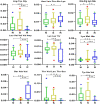Serum metabolomic analysis reveals key metabolites in drug treatment of central precocious puberty in female children
- PMID: 36776772
- PMCID: PMC9912178
- DOI: 10.3389/fnmol.2022.972297
Serum metabolomic analysis reveals key metabolites in drug treatment of central precocious puberty in female children
Abstract
Precocious puberty (PP) is a common condition among children. According to the pathogenesis and clinical manifestations, PP can be divided into central precocious puberty (CPP, gonadotropin dependent), peripheral precocious puberty (PPP, gonadotropin independent), and incomplete precocious puberty (IPP). Identification of the variations in key metabolites involved in CPP and their underlying biological mechanisms has increased the understanding of the pathological processes of this condition. However, little is known about the role of metabolite variations in the drug treatment of CPP. Moreover, it remains unclear whether the understanding of the crucial metabolites and pathways can help predict disease progression after pharmacological therapy of CPP. In this study, systematic metabolomic analysis was used to examine three groups, namely, healthy control (group N, 30 healthy female children), CPP (group S, 31 female children with CPP), and treatment (group R, 29 female children) groups. A total of 14 pathways (the top two pathways were aminoacyl-tRNA biosynthesis and phenylalanine, tyrosine, and tryptophan biosynthesis) were significantly enriched in children with CPP. In addition, two short peptides (His-Arg-Lys-Glu and Lys-Met-His) were found to play a significant role in CPP. Various metabolites associated with different pathways including amino acids, PE [19:1(9Z)0:0], tumonoic acid I, palmitic amide, and linoleic acid-biotin were investigated in the serum of children in all groups. A total of 45 metabolites were found to interact with a chemical drug [a gonadotropin-releasing hormone (GnRH) analog] and a traditional Chinese medicinal formula (DBYW). This study helps to understand metabolic variations in CPP after drug therapy, and further investigation may help develop individualized treatment approaches for CPP in clinical practice.
Keywords: central precocious puberty; drug treatment; key metabolites; metabolomics; serum of female children.
Copyright © 2023 Chen, Wang, Cui, Liu, Wang, Wang, Sun, Liu, Tan, Li, Jin, Xu and Yu.
Conflict of interest statement
The authors declare that the research was conducted in the absence of any commercial or financial relationships that could be construed as a potential conflict of interest.
Figures









Similar articles
-
Serum Metabolomic Analysis of Healthy and Central Precocious Puberty Girls.Clin Endocrinol (Oxf). 2025 Jun;102(6):664-672. doi: 10.1111/cen.15226. Epub 2025 Mar 5. Clin Endocrinol (Oxf). 2025. PMID: 40042104
-
Metabolomic disorders caused by an imbalance in the gut microbiota are associated with central precocious puberty.Front Endocrinol (Lausanne). 2024 Dec 2;15:1481364. doi: 10.3389/fendo.2024.1481364. eCollection 2024. Front Endocrinol (Lausanne). 2024. PMID: 39687078 Free PMC article.
-
Integrated analysis of proteomics and metabolomics in girls with central precocious puberty.Front Endocrinol (Lausanne). 2022 Jul 28;13:951552. doi: 10.3389/fendo.2022.951552. eCollection 2022. Front Endocrinol (Lausanne). 2022. PMID: 35966072 Free PMC article.
-
Central precocious puberty: from physiopathological mechanisms to treatment.J Biol Regul Homeost Agents. 2014 Jul-Sep;28(3):367-75. J Biol Regul Homeost Agents. 2014. PMID: 25316125 Review.
-
Kisspeptin Levels in Girls with Precocious Puberty: A Systematic Review and Meta-Analysis.Horm Res Paediatr. 2020;93(11-12):589-598. doi: 10.1159/000515660. Epub 2021 Apr 22. Horm Res Paediatr. 2020. PMID: 33887744
Cited by
-
Nrf2 activation rescues stress-induced depression-like behaviour and inflammatory responses in male but not female rats.Biol Sex Differ. 2024 Feb 13;15(1):16. doi: 10.1186/s13293-024-00589-0. Biol Sex Differ. 2024. PMID: 38350966 Free PMC article.
-
Advancing Parkinson's diagnosis: seed amplification assay for α-synuclein detection in minimally invasive samples.Mol Cell Biochem. 2025 Jun;480(6):3297-3314. doi: 10.1007/s11010-024-05190-y. Epub 2025 Jan 6. Mol Cell Biochem. 2025. PMID: 39760833 Review.
-
Sleep and Oxidative Stress: Current Perspectives on the Role of NRF2.Cell Mol Neurobiol. 2024 Jun 25;44(1):52. doi: 10.1007/s10571-024-01487-0. Cell Mol Neurobiol. 2024. PMID: 38916679 Free PMC article. Review.
-
Cell-specific α and β subunit expression patterns of Na+/K+-ATPases in the common marmoset cochlea.Sci Rep. 2025 Jul 23;15(1):26814. doi: 10.1038/s41598-025-12239-5. Sci Rep. 2025. PMID: 40702232 Free PMC article.
-
Neurodegeneration models in Parkinson's disease: cellular and molecular paths to neuron death.Behav Brain Funct. 2025 May 31;21(1):14. doi: 10.1186/s12993-025-00279-w. Behav Brain Funct. 2025. PMID: 40450319 Free PMC article. Review.
References
-
- Aiyelabola T., Akinkunmi E., Obuotor E., I, Olawuni D. Isabirye, Jordaan J. (2017). Synthesis Characterization and Biological Activities of Coordination Compounds of 4-Hydroxy-3-nitro-2H-chromen-2-one and Its Aminoethanoic Acid and Pyrrolidine-2-carboxylic Acid Mixed Ligand Complexes. Bioinorg. Chem. Appl. 2017:6426747. 10.1155/2017/6426747 - DOI - PMC - PubMed
LinkOut - more resources
Full Text Sources
Miscellaneous

